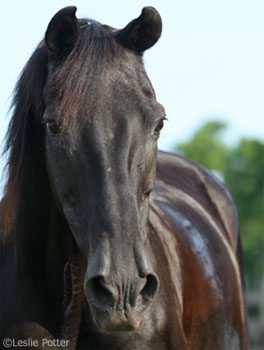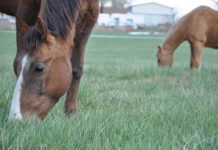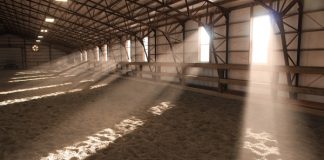In the video below, Dr. Friend explains what he looks at during a routine exam of a senior horse.
My horse, Snoopy, turned 25 this year. Reaching this milestone brings mixed feelings. It’s great that he’s still a happy, healthy guy in his mid-20s. But it raises new questions about his welfare. Is it unfair to ask him to keep toting me around the trails? Will I recognize the signs that he’s ready to be retired?
1. Have your vet out to examine your horse. This doesn’t have to be a comprehensive investigation into every potential problem, but before committing to a continued riding schedule, you need to make sure that your horse is physically sound enough to work.
“Just a general physical is all the horse needs,” explains Friend. “I’ll listen to the heart and look for any kind of cardiomyopathy. I’ll make sure he’s moving freely with no lameness. I always look at the feet to make sure we’re not dealing with a low-grade laminitis. Laminitis is secondary to any disease or metabolic process, so if something is out of whack, like Cushing’s or insulin resistance, sometimes the first thing you’ll notice is sore-footedness. That’s my biggest concern in older horses.”
Before the exam, think about what you would like to do with your older horse. Are you hoping to keep him in competition shape, or are you just looking for a quiet trail partner? Make sure your vet understands what your plans are so that he or she can determine if your horse is sound enough for your riding goals.
2. Evaluate your horse’s weight. Just like humans, some horses will gain weight as they age and their activity level decreases. Others will have trouble maintaining weight. But weight problems are not inevitable, and in most cases you can manage your horse’s health and diet to keep him in good condition.
“[Weight maintenance] comes down to the individual,” says Friend. “The average geriatric Thoroughbred I see is underweight, but an average geriatric Kentucky Mountain Saddle Horse or Tennessee Walker is often overweight.”
 |
| Good, regular veterinary and dental care along with an ongoing exercise program will help keep your horse going strong into his 20s and beyond. Photo: Leslie Potter |
Snoopy’s Morgan heritage shines through in his ability to get fat on next to nothing. My boarding stable doesn’t have a dry lot, so to reduce the risk of weight-related problems like laminitis, he wears a grazing muzzle in the spring and early summer.
For horses with the opposite problem, Friend says the first place to look is the teeth. If a horse can no longer effectively grind his feed, he won’t be able to absorb nutrients, leading to weight loss and poor health.
“A horse’s teeth continually erupts throughout his life,” explains Friend. “But once they run out of growth, that’s it. The teeth can fall out.”
Horses can start to lose teeth as early as their late teens, although plenty will make it to their 30s with a full, functional smile. Horses with the benefit of a solid dental-care history are less likely to have oral problems as they age. Your senior horse should have at least one dental exam each year. Because he has a finite amount of tooth to work with, there may come a time when your vet can no longer float the teeth to keep them primed for grinding. In that case, you will need to make some dietary adjustments.( More on that later.)
3. Re-evaluate your horse’s menu. Healthy teeth won’t do your horse much good if he’s not getting the right feed. Assuming there are no dental problems, your senior horse should continue to have a forage-based diet of primarily grass or hay. Supplementing with commercial feed can be helpful in ensuring your horse is getting all the nutrition he needs.
“You want to make sure your horse is getting balanced nutrition,” says Friend. “Most feed brands offer a balanced senior feed. These are usually more bioavailable, meaning they absorb more readily through the horse’s intestines. As long as you are feeding the recommended amounts, you don’t have to do much more than that.”
When it comes to nutrition, the proof is in the pudding. If your horse is maintaining his weight and has good muscling and a healthy coat, your nutrition program is probably serving him well. If he starts to look dull or gets thin, then something is unbalanced and you should consult your vet to help you pin down the problem.
For horses that can no longer chew regular forage, consider adding what Friend refers to as “oatmeal.” Mix the recommended amount of a forage-based feed such as hay cubes or pellets with warm water and let it soak until you have a mash. Chewing is the first step in digestion, and when your horse can no longer chew, soaking his feed takes the place of that first step. It requires a little extra work for caretakers, but horses can do very well on this regimen, even when they no longer have a full set of teeth.
4. Create the right living situation. For most horses, the ideal arrangement is to spend as much time outside as possible. This reduces respiratory problems and allows older horses to move around all day for better joint health. For horses that aren’t ridden, the ability to roam freely is preferable to being away in a stall where they can’t get any exercise.
Snoopy spent most of his life as a show horse and probably had limited turnout during his prime competition years. After I brought him home, I gradually increased his pasture time from a few hours each day to all-day turnout and a stall at night. Now he lives outside full-time with a couple of other amiable geldings, only staying in his stall on brutally hot afternoons or during overnight ice storms. Some lifelong show horses have trouble adapting to outdoor living. But even a few hours at liberty in the outdoor arena is better than no turnout at all. Gradually increasing the time outdoors and, if possible, adding a compatible turnout buddy, can be one of the best adjustments you can make for your senior horse’s well-being.
5. Exercise, exercise, exercise. When I first raised the question of whether or not to keep riding Snoopy, Dr. Friend’s response was unambiguous. “Definitely don’t stop riding him,” he told me. And I haven’t. Our rides are fairly low-key these days, but I do saddle up a couple of times a week. Besides the physical benefits of staying mobile, Snoopy perks up when we get away from his pasture and visit the neighbors around the farm. The exercise helps with his all-important weight maintenance.
“I’d much rather see a horse get ridden than get fat,” says Friend. “An overweight horse sitting in the pasture is not a healthy horse, and that’s a common misconception. Unless a horse has a chronic lameness or breathing issue, he ought to continue to exercise.”
Friend points to the half-Arabian gelding, Elmer Bandit as an example of a horse who, through a lifetime of good care and exercise, stayed sound, healthy and active to an advanced age. Elmer continued a successful competitive trail riding career through the ripe age of 38, setting a record with his lifetime total of 20,780 miles. While most horses won’t repeat Elmer Bandit’s remarkable career, even occasional riding is better than none.
“As horses age, they don’t recover as well [after exercise],” says Friend. “So a horse that’s only ridden once a month might get more sore than a horse ridden twice a week.” But if your horse is accustomed to that sparse riding schedule, and that’s what you’re able to maintain, then keep doing it. Just proceed with caution and keep your rides slow and easy.
6. Know the signs. As the owner of a senior horse, it’s hard to avoid thinking about the inevitable retirement. A horse with a lot of heart will keep going forever if he’s asked to, but no one wants to ride their horse into the ground.
“A chronic lameness is probably the No. 1 reason that horses get pulled into retirement,” says Friend. “Another one is chronic sore-footedness.” Friend also cautions riders to look out for signs of exercise intolerance, such as abnormally high respiration during exercise that takes a long time to recover or a sudden decrease in stamina. However, in many cases, senior horses can continue to be ridden and are healthier for it.
“Until a horse physically can’t be ridden, it’s better to keep riding,” says Friend. “I am a proponent of exercise. Any human doctor is going to say the same thing—even in your older years, you need to stay active for your cardiovascular health, muscle tone, and even your immune system.”
With a little extra care and attention to your senior horse’s well-being, there’s no reason he can’t continue to be your trusty under-saddle partner throughout his golden years. Simply keeping a spot open in your schedule for riding can improve his quality of life—and yours.
This article originally appeared in the December 2013 issue of Horse Illustrated. Click here to subscribe.







Exercise is definitely key! So many people let their senior horses out to pasture and from there on out they start to go down hill.
Horses may leave the racing industry at any stage of their life, as foals, during training, during their racing career or when they retire.